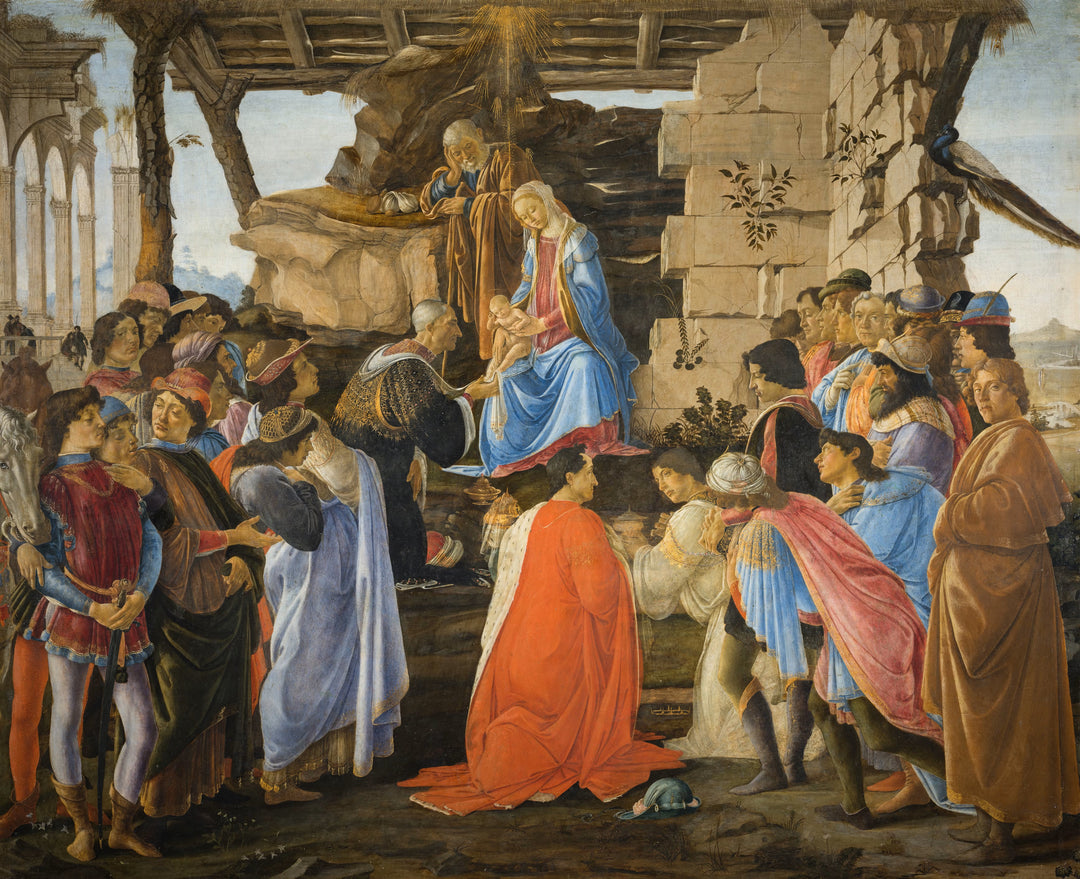
Adoration of the Magi - Sandro Botticelli
| Author: | Botticelli |
|---|---|
| Title: | Adoration of the Magi |
| Original location: | Uffizi Gallery, Florence, Italy |
| Year: | 1475 |
Florence was founded as a Roman colony in the 1st century BC under the name Florentia, born on a fertile plain beside the Arno River. This location, while favorable for trade and agriculture, was militarily disadvantageous, as it lacked natural elevations that would aid in its defense against invasions, making its early history a constant struggle for autonomy and security. By the end of the 14th century, the city was experiencing political turmoil with clashes between internal factions such as the Guelphs and Ghibellines, while its economy was slowly recovering from the Black Death and the bankruptcies of major banking houses.
The 15th century marked a decisive turning point in Florentine history. With the consolidation of power by certain wealthy families, the so-called "magnates" emerged, or what many refer to as the "bourgeois oligarchy"—a ruling class made up of bankers and merchants who, although officially excluded from politics by law, still controlled the government. It was through patronage, client networks, the manipulation of public offices, and above all through arranged marriages with the Florentine nobility that these groups rose to power, laying the foundations for what would later become the Renaissance. Among them, the Medici stood out for their influence in both politics and culture, understanding early on that controlling the Church was essential to dominate the soul of the people. In this way, they secured their authority by controlling the two fundamental pillars of power: political and religious.
A visible symbol of this hegemony is the Vasari Corridor, an elevated walkway built over the "Ponte Vecchio" that linked the "Palazzo Vecchio" with the "Palazzo Pitti," allowing the Medici family to move without fear of being attacked by their detractors. The "Ponte Vecchio," in addition to being a commercial landmark, is a testament to the political situation of the time. The "Palazzo Vecchio," the epicenter of Florentine power in the Piazza della Signoria, remains a majestic monument from that era. Its impact as part of the Florentine Renaissance reached so far that in Boston, USA, you can see a tribute to this Florentine building at "The Pine Street Inn," originally built as a fire station after the devastating blaze known as the "Great Boston Fire of 1872," which destroyed nearly a quarter of the city that to this day is home to some of the world's most prestigious universities, such as "Harvard" and the "Massachusetts Institute of Technology" (M.I.T.).
Within this historical and political context, Sandro Botticelli emerged, born on "Via del Porcellana" in the Ognissanti neighborhood. Raised in an environment where politics, art, religion, and philosophy were deeply intertwined, Botticelli became one of the most representative painters of the Florentine Renaissance, with a style that fused classical idealism with the spiritual sensitivity of Christianity. Among his most celebrated works are "The Birth of Venus" and "Primavera," both filled with Neoplatonic symbolism and humanist influences. Botticelli was protected by the Medici and shared the stage with artists such as Leonardo da Vinci and Filippino Lippi, whom he influenced and from whom he also drew inspiration. Today, he rests in the "Chiesa di San Salvatore in Ognissanti," just a few steps from where he was born.
This canvas is one of his works most laden with political and religious meaning. In the "Adoration of the Magi," painted in 1475, Botticelli not only depicts the biblical scene, but also incorporates contemporary figures, parading the protagonists of Florentine politics toward the manger. It is notable that the Florentine artist wanted the notables of the time to be surrounded by a pictorial frame constructed as a fusion of the very precarious grotto of Bethlehem with the formidable palatial structures of those days, perhaps as a critical nod suggesting how politics sought to install itself at the heart of the sacred. It is perhaps, without words, the most powerful denunciation of the era regarding the intrusion of civil power into spiritual matters. Botticelli, with his delicate touch and penetrating vision, captured the essence of a city where beauty, power, and faith coexisted in a balance as brilliant as it was precarious and often chaotic.